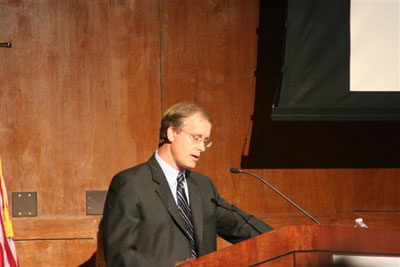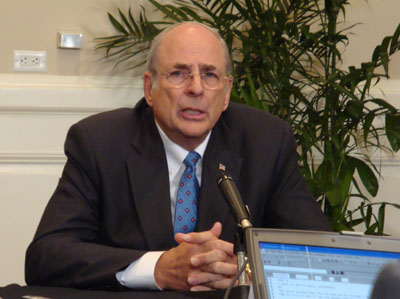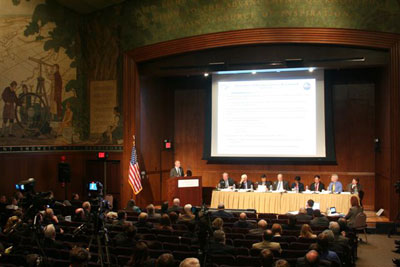Constellation and its challengersby Jeff Foust
|
| The existence of the committee has provided a new opening for those who want to replace the current architecture with any number of alternatives. |
Hanley, meanwhile, tackled some of the concerns that have been raised by the current architecture, from the infamous thrust oscillation issue with the Ares 1 first stage to performance margins for the various aspects of the system. On that later point, Hanley said that Ares 1 had a 22% mass margin and Orion a 23% mass margin for ISS missions, with somewhat smaller margins for lunar missions. “The rocket, Ares 1, is doing very well to be able to lift the Orion to do both the lunar mission and the ISS mission,” he said.
At the same time, though, NASA recently cut the crew size for initial Orion missions to the ISS from six to four. Hanley said that decision was driven not because of mass margin issues, but to make it easier for the program to stay on schedule. “We eliminated that [six-person crew requirement] strictly to simplify the path to get to initial operating capability in March 2015,” he said, “and that was worked in very close coordination with the space station program.”
Hanley added that the March 2015 schedule to begin ISS mission was “stable” currently. “We have a plan to get to that date,” he said, but added the current funding profile made it a challenge to get everything developed to meet that schedule, which has led to reviews and tradeoffs like the Orion crew size. When asked by a committee member if he had a confidence level for the schedule like the one that exists for its budget (Constellation’s current cost estimates through IOC is $35 billion with a 65% confidence, meaning nearly a two-in-three chance the costs will come in at or below that figure), Hanley said a schedule model needed to create that confidence estimate is still under development. “We know we have areas we need to work, so it’s a tight schedule.”
 Shuttle program manager John Shannon said his preference is to fund the existing architecture, but if that’s not going to happen alternatives, like a shuttle-derived side-mount launch system, need to be examined. |
Three challengers
Most of the afternoon portion of the hearing was devoted to several alternatives to the existing Constellation architecture, relying on either shuttle-derived or Evolved Expendable Launch Vehicle (EELV)-derived approaches. That alternatives to Constellation, and in particular to the Ares 1 launcher, existed was hardly a new development. That these concepts were being presented in a public forum, in one case by the head of a major launch vehicle venture and in another by a senior NASA manager, was a significant change.
A case in point was a presentation by Michael Gass, president and CEO of United Launch Alliance, on a proposal to use EELV-derived vehicles in place of Ares 1 and 5. That ULA would talk openly about such alternatives, and in detail, is a break from past practice: as recently as last fall, according to an Orlando Sentinel report, then-NASA administrator Mike Griffin complained to the CEO of Lockheed Martin, one of the two companies involved in the ULA joint venture, about ULA’s reputed efforts at developing alternatives to Constellation. A Lockheed Martin spokesman told the newspaper that the company was “fully supportive of NASA's Project Constellation and is not engaged in any activities advocating alternative launch vehicles.” Times have changed.
In his presentation, Gass proposed using the Delta 4 Heavy to launch Orion in place of Ares 1. “Delta 4 Heavy provides a safe, low-cost capability to launch Orion, we believe, by 2014 with greater than 20% performance margin,” he said. “We believe the Delta system can support Orion with critical cost forecasts and schedules based on recent development experience, and meet the reliability needed for human spaceflight sooner than any other alternative.”
| “Delta 4 Heavy provides a safe, low-cost capability to launch Orion, we believe, by 2014 with greater than 20% performance margin,” ULA’s Gass said. |
Specifically, Gass proposed development of a new launch facility at Cape Canaveral with crew facilities for Orion missions. That would be coupled with development of an “emergency detection system” and other reliability improvements needed for human-rating the vehicle. According to Gass the new pad would cost $800 million and the human-rating work $500 million over four and a half years; after that the Delta 4 Heavy could launch Orion missions each $300 million each. Gass said this system could be run like a traditional launch services program or with greater NASA involvement, such as using the Michoud Assembly Facility in New Orleans for final vehicle integration as well as existing Kennedy Space Center infrastructure, including the Vehicle Assembly Building and Launch Complex 39A.
To further shorten the gap, Gass said that Atlas 5 could be used for launching commercial capsules to the ISS as early as 2013, for $400 million in non-recurring costs for human rating and pad modifications and $130 million a launch. Gass added that ULA was also looking at modifications to the Atlas 5 and Delta 4 that could increase its LEO capability to at least 70 tons, and in the long term to over 100 tons, for NASA’s heavy-lift needs. That work continues studies previously conducted independently by Boeing and Lockheed Martin prior to the creation of ULA. “We joked when we were forming ULA that we would end up with a ‘frankenrocket’, and, lo and behold, it’s becoming true as the best qualities of both rockets are being integrated into our future evolution.”
Gass’s presentation was followed by one from Gary Pulliam, a vice president with the Aerospace Corporation, which had recently performed a study for NASA comparing the costs of using Delta 4 Heavy for Orion versus Ares 1. That study looked at several variants of the Delta 4 Heavy and found that the most technically robust one, using four RL-10 engines in a redesigned upper stage, could not only exceed the technical performance of the Ares 1 but could be developed for $3 billion less. Versions of the Delta 4 Heavy with one RL-10 engine, or no upper stage at all, yielded cost savings of up to $6 billion but with reduced performance.
However, the Aerospace study concluded it would take five and a half to seven years to develop the Delta 4 vehicles for Orion missions, considerably longer than ULA’s estimates or even the current Ares 1 schedule. The cost savings from the Delta 4, he added, did not take into account the costs of systems like the solid rocket boosters and J-2X engine that would now have to be borne by the Ares 5 exclusively, since there would be no Ares 1 to develop and use them. NASA has estimated those costs to be $14.1–16.6 billion, figures Pulliam said Aerospace did not attempt to verify.
Another alternative to Constellation that has been controversial for some time is DIRECT, a proposal by a semi-anonymous group of engineers and others that utilizes shuttle hardware in an alternative system that they believe could be accomplished far more quickly and less expensively than Constellation. In his presentation before the committee, Stephen Metschan said DIRECT’s entry-level booster, the Jupiter-130, could be built for $8.3 billion—$6 billion less than Ares 1—and be ready as early as September 2012. “The bottom line is that we believe the Jupiter can close the gap in the current budget,” he said.
The DIRECT approach, he said, also negated the development of the Ares 5 if the Jupiter vehicle was used with mission architectures that took advantage of propellant depots, with propellant launched by commercial firms or international partners. This, he said, would avoid the need to develop rockets big enough to launch fully-fueled spacecraft. “Once your launch capacity is sufficient to launch ground-integrated spacecraft as one unit, your launcher is large enough,” he said. “The Saturn-class Jupiter is more than sufficient for the exploration program while also having a lower fixed and variable cost than the Nova-class Ares 5.”
One controversial aspect of DIRECT has been the nature of its development: by a group of engineers, at least some of whom work at NASA, that have largely remained anonymous. Metschan mentioned that a “courageous group of engineers and other concerned citizens” have worked on this, but that wasn’t sufficient for one committee member. “Who are you guys?” asked former astronaut Leroy Chiao. “It’s difficult to assess the work without knowing who’s doing it.”
“The anonymous part is critical,” Metschan replied. “There’s a certain amount of ‘blood in the water’,” he added, without elaboration.
| “Once your launch capacity is sufficient to launch ground-integrated spacecraft as one unit, your launcher is large enough,” Metschan said. |
Another shuttle-derived approach presented to the committee involved side-mounted systems on the existing external tank and four-segment solid rocket motors. The concept looks superficilally similar to the Shuttle-C concepts dating back to the 1980s, but shuttle program manager John Shannon, who presented the concept to the committee, said this heavy lift vehicle (HLV) concept was considerably different. “Shuttle-C was an autonomous vehicle that separated from the external tank just like the orbiters,” he explained. “This is simply a first and second stage to inject a payload” into orbit, without any attempt to reuse any element of the second stage, including the main engines.
Shannon proposed a two-phase approach to the HLV. An initial Block 1 model would use existing shuttle assets, including spare hardware, at a development cost of $2.6 billion. A Block 2 upgrade, using new hardware as the shuttle spares run out, would cost $4 billion to develop. The vehicle could be used for both cargo and crew missions, and even for lunar missions, although that architecture would not be as capable as the existing Ares 1 and 5.
Unlike both the ULA and DIRECT presentations, Shannon said he did not believe that the HLV concept—which he emphasized on a number of occasions needed considerable additional study—was necessarily better than the current Constellation architecture. “The Constellation program has put together a viable architecture,” he said, “but it has not been funded to the level we would need to see it through.” He sees the HLV as a backup if funding levels remain insufficient for Constellation. “I think that the first option should be to fund the plan we have, but if we can’t do that, I don’t think we’re ready to cede human spaceflight.”
Commercial and international perspectives
Another person unwilling to give up human spaceflight is Elon Musk, CEO of SpaceX, who talked about his company’s efforts with COTS and commercial ISS resupply. “One thing that I think is important for the public to realize is that we’re currently on a path to sole-source human spaceflight to the Russians,” he warned. SpaceX, of course, hopes to help solve that problem with a crewed version of the Dragon capsule the company is already developing for cargo missions to the ISS.
Musk said that having a commercial capability to access the station for crew and cargo was vital not just to avoid being reliant on the Russians but to free up NASA for exploration of the Moon and beyond. “COTS is really an enabling function for NASA. By having COTS to do commercial crew servicing of low Earth orbit activity at an affordable cost, that enables NASA to go beyond low Earth orbit,” he said. “It seems like the only way forward, the only way we can do exciting things in human spaceflight, is if commercial companies handle the low Earth orbit stuff and NASA focuses on beyond low Earth orbit.”
| “One thing that I think is important for the public to realize is that we’re currently on a path to sole-source human spaceflight to the Russians,” warned Musk. |
In his presentation, Musk reiterated previous statements by the company that it would take SpaceX about two years to develop a crew version of Dragon, with the launch escape system being the driving factor. He added that a “lifeboat Dragon” could be ready in as little as 18 months: this would be docked to the station to serve as a escape craft for crews there; since it would not be launched with a crew no launch escape system would be needed.
One concern for SpaceX and the other funded COTS company, Orbital Sciences, is exactly how long this market for ISS will last. Current NASA plans only call for operating the station until 2016: in his presentation ISS program manager Mike Suffredini said that “our plan is to operate through the end of 2015 and deorbit it in the first quarter of 2016.”
That is also a concern for the station’s international partners, as expressed by ESA director general Jean-Jacques Dordain and Roskosmos head Anatoly Perminov, who addressed the committee by an audio link from Paris. “Roskosmos considers it expedient to extend the ISS utilization term up to 2020 at the minimum,” said Perminov through a translator.
Dordain did not commit to a specific date that ISS operations should be extended to, but did explain how to judge whether the station should continue operations. “The only answer to the question of how long should we use the ISS is… as long as the benefits are worth the costs.”
Dordain added that the international partnership behind the ISS is its most important asset, one that he thought would survive any hardware in orbit. “There is not anymore, for any of the five partners, a separate human spaceflight program,” he said. “We have all together one human spaceflight program shared among five partners.”
 Chairman Norm Augustine said that his committee would present a number of options that would be scored against criteria like cost, risk, and capability. |
A “significant influence”?
As one might expect from a hearing in Washington, the committee also got input from the White House and Congress. In a brief speech as the hearing got underway, presidential science advisor John Holdren said that President Obama was interested in space, noting the conversations the president has had with the crews of the last two shuttle missions. Obama, Holdren said, “is excited by human spaceflight… this is a president who gets it, he understands the importance of space, he understands the importance of human spaceflight.”
Two members of Congress argued that the committee’s findings will play a major role in shaping the future of human spaceflight. “Members and staff are going to give tremendous weight to your findings,” predicted Rep. Pete Olson (R-TX), ranking member of the space subcommittee of the House Science and Technology Committee. “I know you understand the influence your review will wield.”
Olson was followed by Sen. Bill Nelson (D-FL), who made a similar statement about the committee’s work. “In essence, what you decide is going to be the significant influence for the White House, and therefore also for the Congress,” he said. “If you decide that ‘X’ is going to be the case, the White House is going to be a lot more likely to embrace ‘X’.”
| Committee member Crawley: “So these committees do, in fact, sometimes change history, and I think we’re in a position to do that.” |
So what will the committee decide to be the case, and how? The committee dropped few hints about their thoughts during the hearing. During a press conference immediately after the conclusion of the meeting, chairman Norm Augustine said that the committee would not offer a single option but instead “a set of plausible options”, graded against a series of criteria to be developed that will include cost, technical and other risks, and growth potential. “We’ll offer up several options that we believe make sense, and they will run the gamut from more limited programs to very aggressive programs,” he said.
There remains some skepticism, though, about how influential the committee’s recommendations will really be, given the past history of independent panels and their recommendations that were ignored or only partially accepted. One member, though, is more optimistic about its prospects. Ed Crawley, an MIT professor, recalled his work on a space station redesign committee in 1993 headed by Charles Vest, at the time president of MIT. That committee recommended putting the space station in an orbit accessible by the Russians so that Soyuz spacecraft could be used as crew return vehicles. “I had one warm feeling in my heart” the day the Columbia was lost, he said, and that was since the committee’s recommendations had been enacted, the crew on the station was not stranded. “So these committees do, in fact, sometimes change history, and I think we’re in a position to do that.”
